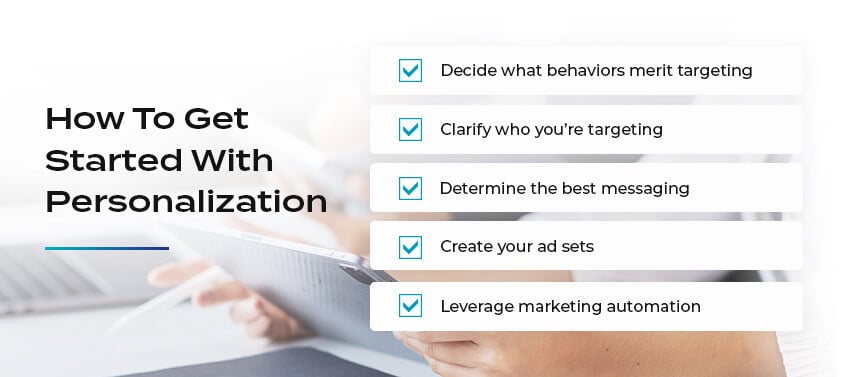What Real Estate Agents Should Know About Marketing Personalization
Puzzle me this: In such a high-touch industry like real estate, why are so many ads and marketing materials so impersonal?
Social media ads, email blasts, and text messages that all say the same thing, almost as if the recipients were one indistinguishable mass. You’ve no doubt received them — maybe you’ve even sent out a few yourself.
But what if marketing materials spoke to people’s needs instead of talking over them? This is precisely what marketing personalization seeks to do.
As you’ll learn in this week’s blog, personalized marketing can help make your business stand out in a sea of sameness.

What is personalization?
If you try to talk to everyone, you end up engaging no one.
Personalization is the antidote to this shotgun approach to real estate marketing, where each piece of communication you send out is laser-focused on a particular target audience. By tailoring your message to address specific needs or preferences, your efforts lead to better results.
Indeed, 72% of consumers say they respond to communications that cater to their interests. Likewise, 97% of marketers saw a rise in business outcomes thanks to personalization.
Of course, it bears pointing out what personalized marketing is not. It’s not one-on-one communication per se — that would be too labor-intensive and expensive to execute. Rather, you’re still targeting groups of people with shared interests and motivations. Put another way, think of personalization as audience segmentation on steroids.
Why use personalization in real estate marketing?
Though you may be one agent, you serve several very different clients: buyers, sellers, and investors.
Even among these segments, there are many sub-categories. Buyers, for instance, can be:
- First-time homebuyers
- Retirees looking to downsize
- Veterans who want to lay down roots
- Newly minted high-net-worth individuals buying their first luxury home
- Investors who want to own a vacation rental
As you can imagine, all these buyers have different motivations, which is why generic messaging like “buy a home today” might not stick.
If you were to segment your audience and create ads tailored specifically to their interests, however, you boost your chances of getting clicks and conversions.

How does personalization work?
At its core, personalization is all about understanding the context behind the customers. Luckily, you don’t have to conduct focus groups to grasp their mindsets and preferences — that’s where data comes in.
By looking at various data points, you can extrapolate insights that can inform your segmentation and messaging. These include:
- Demographic data — This is baseline information, such as age, sex, marital status, education, and employment, which can be useful for determining a prospect’s life stage.
- Behavioral data — This pertains to actions prospects have performed on your website or other marketing platforms. For instance, clicking on listings or opening your email blasts may indicate high intent.
- Contextual data — Details like the device a prospect uses, the time of day they browse online, and their location can tell you how best to reach target audiences.
Where do you get this data?
Of course, you won’t have anything to inform your personalized marketing unless you have data to begin with. Luckily, you may already be sitting on a goldmine of useful data — you just need to know where to look.
- Previous clients — You’ll no doubt have a profile of the people you’ve already worked with, including their budgets, desired home features, preferred neighborhoods, and the like. It helps to create buyer or seller personas using this data so you have a shorthand for the different prospects you’re communicating with.
- First-hand data — If you’ve ever asked prospects to fill out any sort of form, then you likely have a treasure trove of baseline data such as email addresses, location, and budget ranges.
- Cookies — Cookie data can yield a world of insights about how people interact with your site, from where they click, what their mouse hovered on, and even how far down they scrolled. While Google will phase out third-party cookies next year, first-party cookies are not going anywhere.
- Website analytics — Here’s one more reason why you should switch to Google Analytics 4: with the platform’s shift to events-based tracking, you’ll have a clearer sense of what people actually do on your website. It tracks certain actions as “events,” whether that’s using the property search feature or booking a call with you — all things that can help you with personalization.
- Social media ad sets — Chances are, you’ve already done social media campaigns. The good news is that such ads already require you to create targeting parameters which may also apply to other personalized marketing you plan to do.

How do I get started with personalization?
Now that you’ve got the building blocks of personalization down, it’s time to put everything into practice.
- Decide what behaviors merit targeting — Not all behaviors indicate high intent. A person who fills out a form or signs up for your newsletter is definitely a warmer lead than someone who simply comments “Lovely!” on your social post. Focus on the signal, not the noise.
- Clarify who you’re targeting — Begin with the end in mind: who exactly do you want to see your ad and what do you want them to do? You need to understand what makes target audiences tick if you want them to click.
- Determine the best messaging — After you’ve identified the different audiences or personas you want to reach, determine what the most compelling message for them is.
- Create your ad sets — Again, different marketing materials should have different messaging that target different prospects. It’s more time-consuming than your typical shotgun-blast approach, but the extra effort will surely pay dividends.
- Leverage marketing automation — There are many automation solutions that make personalized marketing easier, but do note that these are pay-to-play platforms. If you’re just starting out with personalized marketing, begin with a small campaign. As you push out ever-larger and more complex campaigns, tech tools may be of more value. For instance, CRM suites can serve as a command center for all your customer data and they can even automate the sending of marketing materials like emails or SMS. The key takeaway here is that while technology can handle the grunt work of personalization, agents are still in charge of making sense of the data and making smart use of it.

What are examples of personalized marketing in real estate?
As a real estate agent, you’ll have plenty of opportunities to utilize personalized marketing.
- Email campaigns — This goes beyond simply adding the recipient’s name in the [RECIPIENT] field. If a person has already expressed interest in luxury homes, you may send them an email whenever a high-end property is listed on your site, enabling you to nurture them into a customer.
- SMS — Similar to email campaigns, SMS send-outs can offer personalized messaging that targets specific audiences.
- Social media ads — The great thing about social media advertising is that they allow you to launch simultaneous campaigns targeted at different prospects. This means the ads people see on their timelines are relevant to their own circumstances.
- Pay-per-click (PPC) Ads — Ditto for PPC ads. The great thing about this advertising format is that you only pay when someone clicks, so you can A/B test different messaging until you find one that draws the most click-throughs.
- Websites — First-party cookies allow your website to remember those who’ve visited before and what their behavior was. As such, if they’ve already clicked on a certain listing, your site can display that listing first in the featured properties section to re-spark interest.
What marketing personalization best practices should I be aware of?
While personalization can turbocharge your real estate marketing strategy, there are a few caveats you should be aware of.
- Collect data responsibly — Never intrude on someone’s privacy in the quest for data. By the same token, don’t hassle them with data collection. Whenever possible, allow them to opt-in. For instance, your website could have a cookie policy notice that visitors can accept before they start browsing.
- Strive for subtlety — There’s a fine line between relevance and intrusion. Personalized ads that are overly aggressive or know a tad too much may turn off prospects. Case in point: retargeted ads that follow you everywhere, no matter which website you browse.
- Make sure you have a big enough data pool — Don’t make the mistake of drawing conclusions based on a small sample of data. A single instance does not constitute a trend, after all. The bigger your data pool, the easier it is to validate your assumptions, the better insights you can derive.
Time to get personal!
Personalization makes your marketing efforts more relevant, which in turn helps you connect with more buyers, sellers, and investors. Done right, it’s the secret weapon that can help you leapfrog competitors who are still shouting at a crowd of people instead of having personal conversations with them.
Want more cutting-edge marketing tactics? Be sure to follow our blog!




